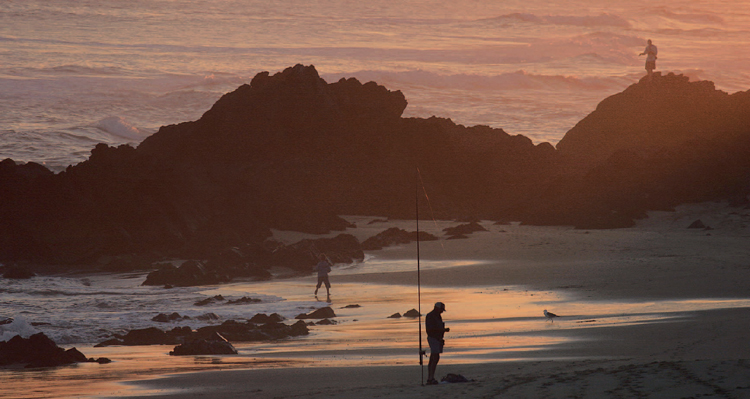
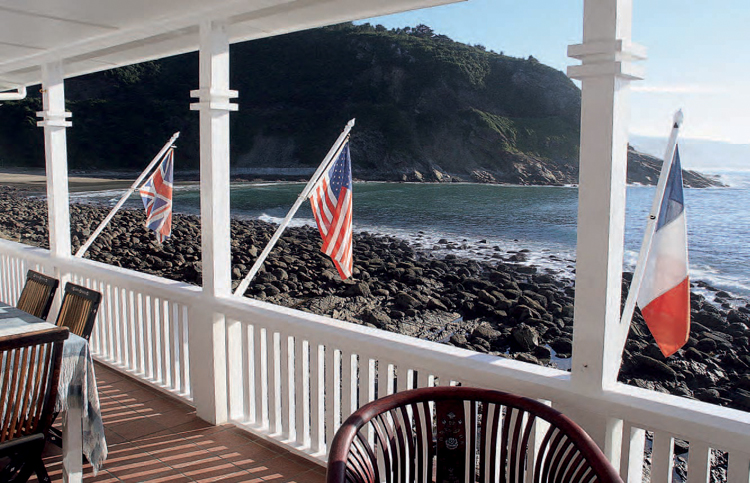
Land’s End in Victoria Bay claims to be the “closest B&B to the sea in Africa”.
The little houses lining the main road of Victoria Bay look impossibly close to the high-water mark. That’s what makes Rod Hossack’s establishment so special – it’s known the world over as “the closest B&B to the sea in Africa”. And for surfers, it has a special meaning, because there’s very little wrong with the waves in Victoria Bay.
The jetty, where the afternoon fishing brigade gathers in hope and jest most afternoons, was built by a young book-keeper called Bramwell Butler after he won the £125 000 Calcutta Sweepstakes. He offered 10 grand to the Dutch Reformed Church but it said, “No thanks, it’s gambling money”. The Methodist Church, according to legends, said “Life’s a gamble and thank you very much”. Butler proceeded to buy up most of Vic Bay’s main road.
Rod Hossack’s first love is surfing, and when you don’t see him out on the Vic Bay waters he’ll be up north off Jeffreys Bay or somewhere really exotic around Indonesia. Maybe Bali. His place, Land’s End, is a delight to visit. Rod calls himself “just a waiter from Vic Bay” and serves a mean breakfast indeed.
He often takes instruction and advice from a ghost called Daphne Marais, the late wife of a former owner of the building.
“A while back, a clairvoyant came to stay,” says Rod. “He asked me if I knew that a woman came to sit in that green chair in the corner every morning for breakfast.”
Apparently, Mrs Marais approved of all the changes Rod had brought to Land’s End. Since then, he lays a breakfast place for her every day, even pulling her chair out slightly like a true gentleman.
We stay with Rod every time we travel on the Garden Route. The wild wavy ambience is perfect, and we never cease to take inspiration from the words on the sundial outside: “Love like you’ve never been hurt; Work like it’s not for the money; Dance like no one is watching ...”. – Chris
Pincushions dance with the wind that often batters the hardy fynbos.
A moulting chameleon makes its unsteady way across thin-stemmed fynbos shrubs.
On a hot spring day in the Western Cape, the sweet, herbed smell of fynbos rises in waves. A day hike through it leaves you fragrant from head to foot.
Fynbos grows in the tiniest floral kingdom in the world, the Cape Floral Kingdom, the only such ecosystem to be contained entirely within one country.
Spread in a cupped crescent, this kingdom is found on the rim of South Africa’s southernmost reaches, never more than 200 kilometres from the sea and often within metres of the breaking waves. With Vanrhynsdorp as its far northwestern limit, the fynbos biome broadens as it swings south in the vicinity of Cape Town, and narrows eastwards, tailing off near Grahamstown in the Eastern Cape.
In this small area, equivalent to a thinly smeared Portugal, there are more than 8 500 plant species, and, of them, 70 per cent are endemic – found nowhere else.
Just for purposes of comparison, the Cape Peninsula alone has 2 285 plant species in an area smaller than London. Compare that to the entire British Isles, which has only 1 500 species, and, of these, a mere 20 are unique.
In fact, if you had to measure the sheer number of species per square kilometre, this thin-leafed, shrubby ecosystem beats other plant kingdoms hands down in terms of concentrated diversity. It has three times more plant species per square kilometre than the fabulously lush rainforests. For this reason it was declared one of the world’s 34 biodiversity “hotspots” and, in 2004, confirmed as a treasure of the Earth, a World Heritage Site.
But why is the Cape Floral Kingdom so rich? Paradoxically, because its environment is so hostile. Just like rainforest, the sandy soils fynbos thrives in are astoundingly poor, leached of nutrients.
Admiring biologists maintain there is nowhere else on Earth where life forms have evolved to flourish in such difficult conditions, so rapidly, with so much grace and cunning. Fynbos has adapted – and continues to adapt – to huge variations in climate. In some of its habitat, specifically the Cape Peninsula, the rainfall can be a staggering 2 500 millimetres a year. Further north, fynbos survives on a miserly 400 millimetres.
Some southern slopes have no sunlight for several months of the year, while others have to survive hot, dry summers. In winter, the fynbos is hammered by rain and rip-roaring winds that can come from all directions.
It is this lack of constancy in its habitat that has led to the extraordinary diversity in fynbos. Some species are limited to tiny areas, where they have adapted to very specific conditions. This is why development and invasive alien plants are such a terrible threat to fynbos. Some types of fynbos have all but vanished except for little islands of growth. The clearing of an area for housing or grapevines can completely eradicate several species forever.
Typical fynbos plants are proteas, ericas and restios (reeds). But this floral kingdom is the origin of some of the world’s favourite plants:
Humans are used to seeing fire as a hugely destructive force. But the fynbos has not been destroyed. It has been renewed – unless the fires happen too often, or are too hot.
gladioli, freesias, nerines, agapanthus, ixias, as well as proteas, which take so many forms. Flower boxes around the world would be that much less colourful if it weren’t for geraniums and pelargoniums – which have their origins in fynbos.
With so many unique plant species, fynbos has very particular pollinators. There are tailor-made long-tongued bees and flies that can probe tubular erica flowers for nectar, and fynbos-adapted beetles that thrive on the pollen and nectar of protea flowerheads.
Many erica and protea species rely on tiny, hyperactive, iridescent sunbirds, with their long, curved bills, swooping triumphantly from bloom to bloom on a permanent sugar-high. The larger, noisy, charismatic sugarbird that soars over the fynbos, trailing its long tail feathers, is an important pollinator for proteas, and, like the sunbirds, is rewarded with a steady supply of nectar.
Other protea species have even recruited rodents. They have dull flowerheads that hang close to the ground, with yeasty-smelling nectar and nutritious seeds that certain mice find completely irresistible.
Because fynbos grows in such poor soil, it does not have many nutrients to offer insects, but it does recruit some ants to help it survive fires. Protea mimetes, for example, has a seed with a fleshy attachment that is particularly delicious for the hairy vlei ant and the pugnacious ant. The ants drag the seeds to their underground nests and eat off the flesh, leaving the hard seed, protected from rodents, planted in exactly the right place. When a fire sweeps through the area (and it inevitably will), the seeds respond to the heat through the soil, and begin to grow.
In fact, the way that fynbos thrives on sweeping coastal fires confounds most people. Fynbos depends on fire for regeneration. If there are no fires, fynbos will eventually become moribund and die of old age. It encourages fire with its aromatic oils and loads of easily dried-out branches.
Humans are used to seeing fire as a hugely destructive force. After a spectacular blaze, television commentators typically enumerate in doleful tones the number of hectares destroyed. But the fynbos has not been destroyed. It has been renewed – unless, of course, the fires happen too often, or are too hot.
Anyone looking at hectares of blackened vegetation after a fire must wonder how fynbos survives this. Yet only a few weeks after a fire has swept through, the first signs of life appear – the graceful reddish-orange firelilies spring up. Smoke, apparently, is their stimulus for flowering. In fact, horticulturalists have found that it is far easier to grow certain fynbos plants with water that has come into contact with smoke.
The heat of the fires is another stimulus – the protea seeds buried by ants need heat to crack their hard coats underground.
The mere fact that so much vegetation is suddenly removed is another stimulus – colourful watsonias bloom en masse (an extraordinary sight) when soil is left open and unprotected.
The ideal time period between fires is eight to twenty years – enough to replenish the seed banks.
For centuries, fynbos was seen as useless. But in the last few decades its value has become increasingly obvious. The best-known use of fynbos is in the cut-flower industry. The local and foreign market for fresh and dried flowers and foliage is worth well over R50 million a year, and employs 20 000 people.
Some reed species have long been used for thatching. Rooibos is one of the best-known fynbos plants, used since the ancient times of the Khoi to make a healthy tea. Honeybush is becoming increasingly popular. Buchu is also famous. Walking through buchu is a natural aromatherapy experience. And the old folk used to love buchu brandy – for purely medicinal purposes, of course. – Julie
Fynbos has adapted, and continues to adapt, to huge variations in climate. The lack of constancy has led to an extraordinary diversity of plant species.
Certain fynbos species are limited to such small regions that clearing an area for farming or housing can wipe out an entire species.
Fynbos has adapted to its water-poor environment in a number of ways – thin, hairy leaves minimise water transpiration.
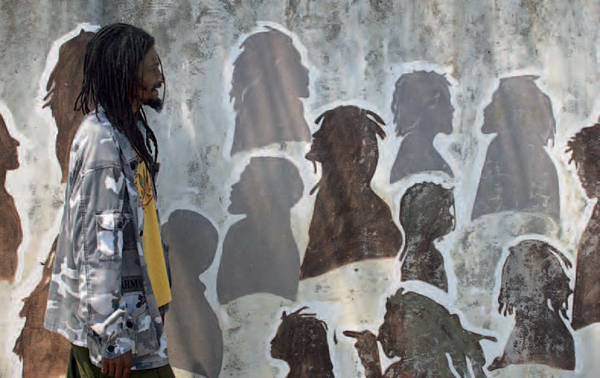
Maxie Melville of Judah Square, standing beside the mural that was done of the community’s profiles.
We arrive at Knysna, where my jaunty hero François Le Vaillant came a-wandering back in the late 1700s in search of a decent elephant-foot breakfast and a specimen of the recently renamed Knysna turaco (formerly the Knysna lourie), which Le Vaillant called a turacus. He was shocked to see how the colonists lived in their buffalo-skin-roofed huts when they could have built timber palaces. But when he arrived at a place called Pampoenskraal, Le Vaillant fell in love with the forest and built an open-air dwelling for himself.
He declared that his spot at Pampoenskraal was far superior to the “sumptuous grottoes of our wealthy financiers, the magnificent villas of the English citizens, nabobs and plunderers”. Those “grottoes and villas” took a couple of centuries to arrive. So did the “English citizens, nabobs and plunderers”.
When the Duke of Edinburgh visited Knysna in 1867 to bag a couple of the local elephants for his trophy wall back home, the village consisted of 25 “European homes” and a wharf. The real cowboys of the Knysna forests were, of course, the woodcutters. They lived off honey mead, sweet potatoes, wild boar, fish, pumpkins, bushbuck haunch, bread and coffee – mostly the kind of food you’d only find in a very special deli today.
Another legendary Knysna character was George Rex, who may or may not have been the illegitimate son of England’s George III. Anyway, it didn’t hurt to have that kind of reputation in those days. Rex did what most men in the district would do: he kept ostriches, hunted elephant and cut timber. He also persuaded the authorities in Cape Town to build Knysna into a proper port.
The Belvidere Church and its springtime blossoms.
We shop for victuals and venture off to our digs, the Endlovana (Little Elephant) Coastal Hideaway near Belvidere. It’s a tented camp in a world of fynbos and milkwood, one dune away from the beach. Working on this family property and learning a few environmental lessons along the way has turned the owner, Susan Campbell, from “arrogant and ignorant” lawyer into someone dedicated to low-impact living. She is certainly not on the side of the rampant developers of the area.
After our first night in Endlovana, Jules writes in her journal: “It makes you wish your childhood holiday memories had been of this. Being in a tent exposes you. You feel the coastal winds, and the light veil of mist on your face. It changes your hair and the texture of your skin. You feel sleepy more often. You eat well. Last night we used the open-air shower on the top deck, bathing in warm water in cold night air, watching the stars. This is a generous place.”
The next day, we drive on through Knysna for our appointment with Maxie Melville in the township of Khayalethu, or more precisely the precinct of Judah Square.
Seen from a distance, Khayalethu has a stylish woodcutter thing going for it. Every building is handmade with planks, there are vegetable gardens and shops are garishly painted. It looks like a large, rather funky, forest village where real people hang out. Poor, granted. But guaranteed to be interesting.
It is Saturday. Kids are playing cricket in the streets, using tomato boxes for wickets and crude bats. Near Judah Square we see the “Rastamuffins”, pre-teens in their dreadlocks goofing around near a wall of Rasta quotations.
Maxie’s home is not a dagga den. It is a small, clean RDP house with timber add-ons. Someone has been baking; you can smell it has that “Granny’s just been and she left something for pudding” aroma about it. There is nary a trace of a spliff, a joint, a bong or a Rizla rolling paper.
Maxie, 40-something, lanky, dreadlocked and square of jaw, invites us to sit.
“At one time the Rastas of Knysna lived apart, dotted about Khayalethu,” he says. “It was awkward. We’re vegetarians, and don’t drink alcohol. People had meat braais around us, there were shebeens, drunks on the street. Then we put up a petition with 2 000 Rasta signatures, asking the authorities for our own space. Welcome to Judah Square.”
We have to ask about the dagga, which is part of the Rasta culture.
“All our households have a plant,” he says. “In summer they’re visible, because they grow above the fence line. But we have no crime. There is no rape, no robbery and no assault in Judah Square. We never pick up a gun. We never take up hard drugs. To us, ganja is like food. It is our inspiration. It is the herb of herbs.” – Chris
The Knysna forests were home to hundreds of elephants, now vanished. But orphaned elephants educate tourists about their kind. And some say Big Foot still roams the wild forests ...
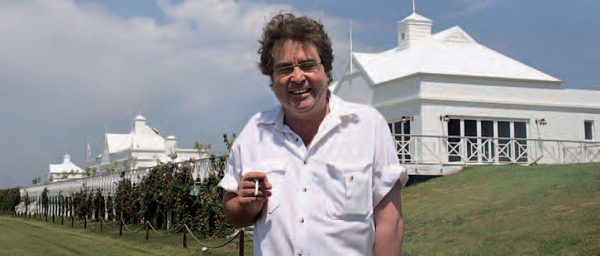
Martin Rattray, with the pavilions he designed for Kurland behind him.
In the course of his brilliant career, Martin Rattray has designed classy coastal homes, hotels and polo complexes collectively worth more than R1-billion.
He lives up at the family estate – Fairview Farm, deep in The Crags outside Plettenberg Bay.
The signs in Martin’s coach house-cum-office read: “Let us build such as our children will thank us for”; “A single ugly villa can dethrone a dynasty of hills”; “Beauty is necessary”; “Man becomes what he sees”; “The quality is remembered long after the price is forgotten”; “Piss off, I’m busy”.
We want to know about the developments along the South African coastline. How can we get everyone to behave and build nicely?
Martin is immediately on the case: “De gustibus non disputandum, old boy. About taste there can be no discussion.”
“Does the country need a Coastal Aesthetics Committee?” we ask.
“No teeth, no teeth at all,” he says. “If you want to make sure there is visual, stylish harmony on the coast, it must be written into the building codes. In any village, it is good to have a signature characteristic, a flagship design. South Africa, by now, should have a style whose mother is Cape Dutch house and whose father is Ndebele cottage. Look at those Australians and what they’ve done with the typical Outback farmhouse.
“And if Plett were in Scotland, you would find an established village built in the time-honoured fisherman style by people using local material, people with a strong sense of community. They would have lived off the sea and there would, of course, be a fishing harbour with a market. It would look marvellous.”
What about “low maintenance”?
Martin visibly cringes at the term. Then the light of battle goes on in his eyes and he raises his wine glass like a saluting gladiator.
“Mining camp mentality. All is created in a rush, with regard only for usefulness. And then there is Nouveau Riche: the “Look at all my Money” gang. It will still take a few generations of wealth before people have the confidence to relax and not feel the need to show off. I have a client, for instance, who has opted to disguise her spa, gym and steam room in what looks like an old farmhouse. That’s style.
“Charm is marketable. Charm is valuable. I will send Horst [his Rottweiler] after any person who holds charm subservient to low maintenance.”
The polo estate of Kurland at The Crags.
Keurbooms Beach near Plettenberg Bay – one of South Africa’s finest.
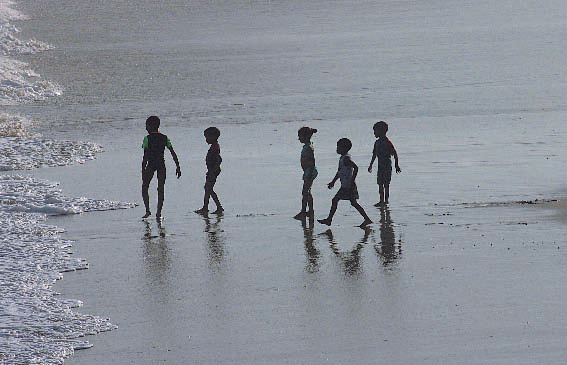
Children and the sea, that eternal delight.
We drive out to the Kurland Estate. Martin has designed much of this grand homage to polo and we’ve specifically come to see his new pavilion, an exquisite series of three white buildings, spacious and airy, with the delicate Victorian lines of spun sugar.
Some time later, we all get thirsty and venture off to Enrico’s at Keurbooms Strand. The late afternoon setting on the beach is superb. We quaff wine and ale and meet some of the locals, who delight in passing on scurrilous stories about all the rich folk living at Plettenberg Bay.
Martin appears from nowhere and calls out, “Enrico, that fantastic French café music, please”.
And suddenly Paolo Conte is among us on that deck with his bistro sounds and everyone, including the waiting staff, is jiving away joyously. Down at the shoreline, children dance with the waves and the setting sun shoots through the tankards of ale and somehow we are all talking about onions.
“Did you know,” says an owl-eyed somebody, “it’s still legal in certain states in the USA for housewives to throw onions at persistent salesmen? Apropos nothing, of course ...”
I remember Enrico Iacopini, who used to own the wildly successful Roma Pizzeria in my stamping ground of Melville, Jo’burg. He left Melville in 1998 for a quieter life. Not with Martin Rattray about, though.
“It’s not safe down here, either,” Enrico says with a wide grin. “Just last week, Martin threw a pumpkin at me.”
Then drunken marriage certificates are produced, a wealthy woman’s pearl is purloined, photographs are taken and Martin throws himself into a long tale about one Lady Sophia Gray, “who rode around on churchback, designing horses ...” – Chris

One of the first buildings in the Storms River area was a “hunting box” built by TH Duthie. During the 1800s, an average of 60 elephants were shot every day.
The air is the colour of caramel as we drive into Storms River Village and check into The Woodcutter’s Cottage, the restored home of a forester.
The sky has turned beige from nearby fires as we climb into a large tractor-trailer with a busload of Dutch tourists for Storms River Adventures’ Woodcutter’s Journey into the Plaatbos Nature Reserve.
We are lucky enough to have Miss Tsitsikamma, the lovely Jossy Abrahams, as our guide. We venture into a forest glade where more than five hundred plant species are to be found. Ferns are big business around here, with 16 tons of greenery being sent overseas every week to garnish the flower bouquets of European romantics. The harvesting is carefully monitored, to keep it sustainable. Jossy gives us an insight into the forest.
“The blackwitch hazel is a natural air conditioner,” she says. “The hairy undersides of the leaves hold moisture and gradually release it during the heat of the day, keeping the forests moist.
“And here’s the malleblaar (crazy leaf). Some of its leaves are sweet, while others are bitter. That’s to confuse the animals. The kammanassie tree gives off a milky latex if you cut it. It fools the stomach into feeling satisfied quickly, so that the animal moves away.”
The forest road we are slowly puttering down was once the national route through the district, built by the famous Thomas Bain and his army of convicts in 1885. Some say it was the celebrated road-making genius’s greatest work, as it wound through the most spectacular part of the Garden Route and crossed the Groot, Bloukrans and Storms rivers.
After the forest trip, we prepare for the canopy adventure, which we have mistaken for a gentle stroll on some kind of platform up in the trees above us.
Then our guides start hauling out the harnesses. Startled, we look up at the walls of the adventure company’s office and see photographs of happy people speeding through the forest treetops, attached to wires.
Soon enough, we are all in the full swing of the adventure, and the adrenaline flows as we babble away like howler monkeys up in the penthouse of this magnificent forest, caught up in the rush of effortless green flight. We stay silent for just long enough to catch the flight of a purple, red-winged Knysna turaco and hear the insistent wild call of a forest buzzard as it flies nestwards.
Ashley Wentworth – who once held down an executive job with an international pharmaceutical company – runs Storms River Adventures.
When big fires sweep through here, the best bet is to be in the indigenous forest, always moist and dense. Pines and blue gum plantations ignite like torches.
The highest bungee jump in the world is at Bloukrans Bridge.
At 46, Ashley sought to change his life completely. So he and his partner Fiona Green came here and turned Storms River Adventures into an ethical, eco-friendly, job-creating operation. They won award after award in the world of fair trade.
Storms River Adventures is at the epicentre of empowerment in the village, which includes a catering company that serves very good tramezzini, and a shop full of locally made crafts.
Ashley’s company has trained more than 360 guides, who are now working all over southern Africa and beyond. We ask about the fires.
“You live with that danger all the time,” he says. “The last big one we had was in 1998, just after we arrived. The police came around one morning and ordered the village to evacuate. We took all the staff down to the rugby field, which is surrounded by indigenous forest. The fire bypassed us, leaving most of the village unscathed. We fear smoke inhalation more than the fire itself.”
Later on, we wander through the village and find an intriguing collection of Cadillacs in an Art Deco showroom right next door to a Victorian hotel complex.
Not only is Jan du Rand the Cadillac Man, he is also the laird of the Tsitsikamma Village Inn, built on the site of the first old hotel, complete with original yellowwood floors in the old bar.
And the Cadillac Junction outside?
“I grew up in Hanover in the Karoo. Back in 1958, when I was a teenager, one Bok Theron bought himself a Cadillac and only used it on Sundays. I admired that car so much.”
Warming to the subject, Jan du Rand takes us off to his Cadillac Shack, a showroom done up in deep rose pink. His pack of well-groomed big-fin Cadillacs stands waiting. There is also a gleaming red 1973 Ford Mustang, with what amounts to a 7.8-litre engine.
“That’s my muscle car,” says Jan. “Wanna go for a spin?”
As we pull out into the road, everyone stares. The Mustang growls and leaps forward like a beast desperate to run. Jan is weighing up the odds between going fast and possibly being caught. As he eases his foot off the accelerator, we spot a local traffic cop lurking in the undergrowth with his radar camera and reflective shades.
There is something completely primeval about the Tsitsikamma area.
On the way back, Jan lets the Mustang out of its cage and quantities of proverbial rubber are burnt.
A light drift of smoke ash begins falling on the village. We have a date with the bungee people over at Bloukrans Bridge. They say, “Come on over, we’re ready for you”.
“I’m sure they won’t let us dive into fire,” I comment to Jules without any real conviction. Not only am I going to attempt the world’s highest bungee jump in my middle years, but there is the added thrill of going down in flames as well.
We hit the N2 back towards Plett and the Bloukrans Bridge. Smoke rises ominously from both sides of the highway.
“No jumping today. So sorry. We’ve just received orders to evacuate.”
We turn back onto the N2, headed for Storms River Village, which is in uproar. The main road is alive with people, carrying their prized possessions and pets to safety.
But at midday, the hot berg wind suddenly swings around and turns icy. The prayed-for cold front has arrived.
The evacuation orders never come. The fire has bypassed Storms River. The villagers – and we – heave a collective sigh. Safe this year. – Chris
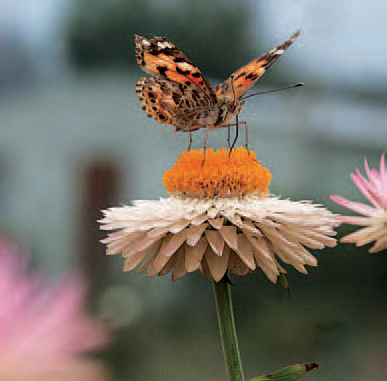
A butterfly at work in a Storms River Village garden.
Left Storms River Adventures took great care not to damage the huge trees used as platforms, mostly hard pear and Outeniqua yellowwoods. Cables are cushioned with rubber.
Right Mountain biking through the forest in the early morning comes highly recommended.
Soon enough, we are all in the full swing of the adventure, and the adrenaline flows as we babble away like howler monkeys up in the penthouse of this magnificent forest, caught up in the rush of effortless green flight.
One of Jan du Rand’s Cadillacs, an unlikely sight in the little village of Storms River.
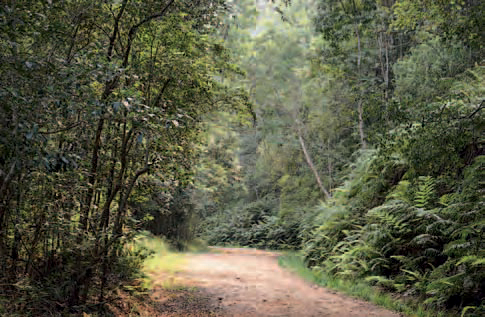
The indigenous forest is full of mossy glades, ferns and towering trees.